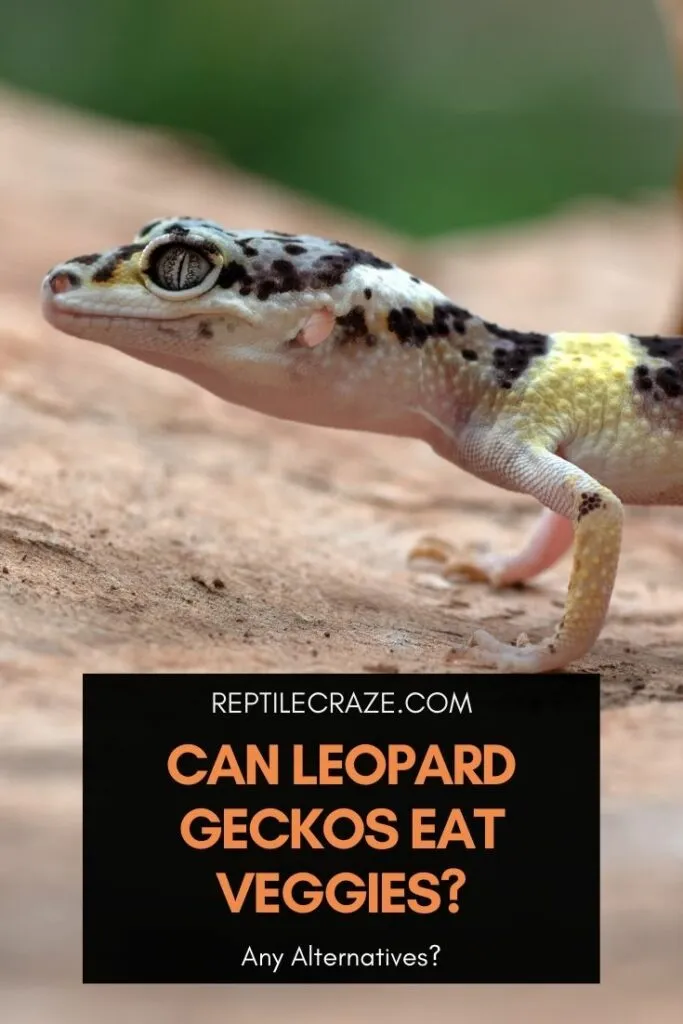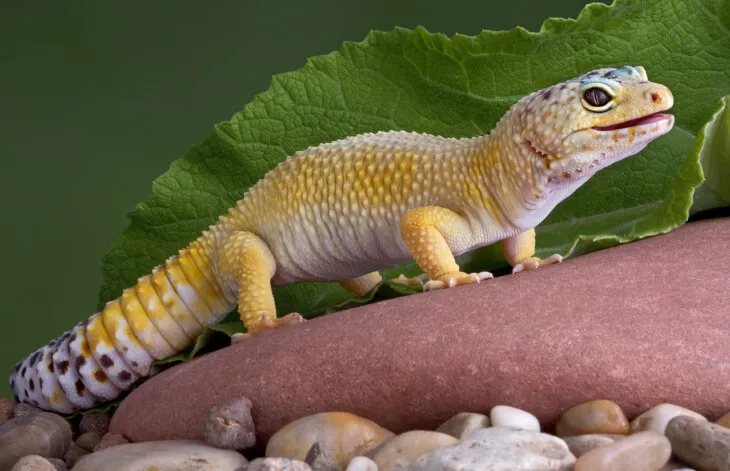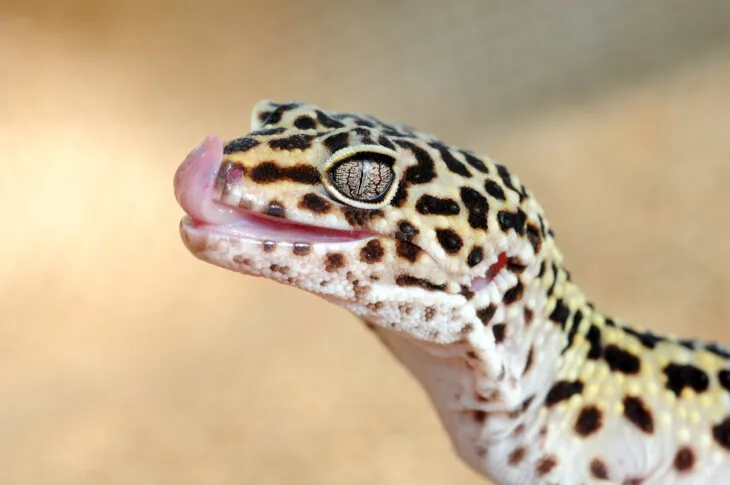
We all know that our Leopard Geckos benefit from a varied diet that gives them a wide range of vitamins, minerals, and other nutrients. Vegetables are highly nutritious, so, can Leopard Geckos eat vegetables as part of their diet?
Leopard Geckos cannot eat vegetables as part of their diet. Leopard Geckos are insectivores, a type of carnivore that eats almost exclusively insects. They lack the anatomy needed to take nutrition from plant matter. Vegetables pass through the gut as undigested material and could cause impaction.
Let’s find out more about why vegetables are not suitable for Leopard Geckos, and how to give them the benefits of vegetables safely.
Table of Contents
Leopard Geckos Cannot Digest Vegetables
Leopard Geckos are carnivores and must eat other animals to survive. As Leopard Geckos eat primarily insects, they are classified as insectivores. But, they can eat other meats such as baby mice and even baby Leopard Geckos.
Leopard Geckos’ digestive systems differ drastically from those of herbivores. Herbivores can survive by eating only vegetation.
Leopard Geckos’ Teeth Can’t Grind Down Vegetables
Herbivores have flattened teeth. These are specialized to grind down plant matter. Physical grinding is an important part of digesting plant matter.
Some reptiles don’t have flattened grinding teeth but do eat vegetation. So, they need to swallow rocks. These rocks are called gastroliths and physically grind down vegetation within the gut.
Omnivores, which eat both meat and vegetation, have some flattened teeth and some pointy teeth. Pointy teeth are designed to grip and tear meat.
Carnivores, including Leopard Geckos, have pointy teeth only. These are meant for gripping and slicing insect prey.
Leopard Gecko teeth are useless for grinding down vegetation. Neither do Leopard Geckos swallow gastroliths, nor have a gizzard in which to store gastroliths safely. So, Leopard Geckos have no way to grind down plant matter.
Leopard Geckos’ Guts Can’t Break Down Vegetables
Herbivores have huge guts that can store a lot of vegetation. They also have specialized sections of the gastrointestinal tract.
Organs such as a cecum, or special stomachs that are split into chambers, allow herbivores to break down plant matter slowly. The process is very complex.
In addition to this, herbivores (and some omnivores) also have a synergistic relationship with microorganisms that live in their digestive system.
These microorganisms produce the enzyme cellulase. Cellulase breaks down cellulose, which is what plant fiber is made of.
Leopard Geckos’ digestive systems do not have these features. Therefore Leopard Geckos cannot break down plant matter or extract nutrients from vegetables.
Like other carnivores, their gastrointestinal tract is short and does not hold a lot of
Leopard Gecko stomachs are simple sacks. In the stomach, their prey is exposed to hydrochloric acid and pepsin. Pepsin breaks down protein bonds. Meat contains a lot of protein, so pepsin is very important for carnivores.
The

Leopard Gecko Bowel Impaction
As a result, vegetables are likely to cause an impaction. In Leopard Geckos, vegetables aren’t ground down by the teeth or by gastroliths.
The cellulose structure isn’t broken down by cellulase. And, the vegetation moves through the gastrointestinal tract faster than in herbivores.
So, by the time it reaches the bowel it is still largely undigested material. It could easily block the bowel and cause an impaction. This leads to constipation, appetite loss, bloating, lethargy, and if left untreated, is fatal.
Tip: If you’d like to know what human foods leopard geckos can eat, read this article on our site!
Leopard Geckos Get Nutrients From Vegetables Via Gut-Loaded Insects
There is a way that Leopard Geckos can safely benefit from the vitamins, minerals, and dietary fiber that vegetables provide. This is through gut-loading.
Gut-loading means feeding a nutritious diet to insects in the 48 hours before giving them to your Leopard Gecko. When your Leopard Gecko eats the insect, he benefits from all the nutrients within the gut and tissues of the insect.
Not all insects can be gut-loaded easily. But, most staple feeder insects for Leopard Geckos, such as mealworms, crickets, and grasshoppers, can be.
To gut-load your feeder insects, give them vegetation such as raw potatoes, carrots, apples, or kale in the 48 hours before offering them to your Leopard Gecko.
In addition to vegetables, give the insects a commercially-made gut loading powder such as T-Rex® Calcium Plus
You should also ensure the insects are hydrated, by offering a bug gel such as Fluker’s Cricket Quencher. Your insects won’t drown in the bug gel, and will again be fortified with vitamins and minerals.
Leopard Geckos Should Never Be Given A Vegetable Mash
On the internet, there are some mentions of giving malnourished or poorly Leopard Geckos a vegetable mash, to help them recover. Given what we have learned above, this doesn’t make a lot of sense.
We reached out to a specialist vet, to seek clarification. Here’s what we found out: Vets do not feed a vegetable mash to Leopard Geckos, nor do they prescribe it.
The vet believes that the confusion may have arisen in relation to hydrolyzed protein mix. The mix contains soya that has been broken down by a chemical reaction involving water.
Soya is plant matter that is extremely high in protein. Vets feed this mix to malnourished Leopard Geckos.
Hydrolyzed protein mix is designed to deliver nutrients that are highly bioavailable to the body of the Leopard Gecko.
During a period of malnourishment, the bioavailability of the building blocks for living becomes the most important thing.
The soya in the mixture has been prepared in such a way as to make the protein within it accessible for the body to utilize quickly.
Hydration is also a key component of many reptile illnesses. The hydrolyzed protein mix delivers a lot of hydration, alongside bioavailable protein and other nutrients.
The mix is also designed to be highly palatable. This means that it tastes delicious, so the unwell Leopard Gecko wants to eat it. However, hydrolyzed protein mix is not designed to be a complete diet. It is for use in the short term only.
So there you have it! Despite being plant-matter-based, a hydrolyzed protein mix is not really a “vegetable mash”.
Please do not try to feed any vegetable mash to your Leopard Gecko. Always seek veterinary advice if your Leopard Gecko is unwell.

Why Are Leopard Geckos Sometimes Seen Eating Vegetables?
Sometimes, Leopard Geckos do eat vegetables when they are offered. This does not mean they should be eating vegetables.
Leopard Geckos in captivity might eat vegetables simply because they are there. Eating is an enjoyable activity and sometimes new foods need to be tried before an animal discovers they are unsuitable.
It is not an ideal explanation, but is similar to explaining why children eat mud and dogs eat legos. For the most part, Leopard Geckos will not be tempted to eat vegetables.
Leopard Geckos are triggered to attack prey when it moves, so vegetables are unlikely to be seen as prey.
But, there is another explanation for why Leopard Geckos might eat vegetation. Some obligate carnivores, for example, cats, cannot survive on vegetation. Yet, they are often seen eating grass. Why would they do that?
Theories suggest that sometimes carnivores purposefully eat vegetation when they have an upset stomach. It could be to trigger regurgitation, or to sweep through the gastrointestinal tract and cause a large defecation.
While research into reptiles and Leopard Geckos is far less advanced, it is possible that they might use vegetation in the same way as other carnivores.
Fruit Is Even Worse Than Vegetables
Fruit is a form of vegetation, and should not be fed to Leopard Geckos for all the reasons we have discussed above. But, fruit is even worse than vegetables.
This is because fruit is very acidic, and contains a lot of sugar which can damage your Leopard Gecko’s teeth. Find out more reasons why fruit should never be fed to Leopard Geckos in our feature article.
- Enchi Ball Python: A Unique and Stunning Morph of Python regius - March 27, 2025
- Emerald Tree Monitor: The Enigmatic Green Guardian of the Rainforest - March 26, 2025
- The Egyptian Cobra (Naja haje): A Fascinating Serpent - March 25, 2025
